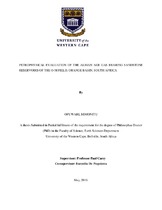| dc.description.abstract | Petrophysical evaluation of the Albian age gas bearing sandstone reservoirs of the O-M field, Offshore South Africa has been performed. The main goal of the thesis is to evaluate the reservoir potentials of the field through the integration and comparison of results from core analysis, production data and petrography studies for the evaluation and correction of key petrophysical parameters from wireline logs which could be used to generate an effective reservoir model. A total of ten wells were evaluated and twenty eight sandstone reservoirs were encountered of which twenty four are gas bearing and four are wet within the Albian age depth interval of 2800m to 3500m. Six lithofacies (A1, A2, A3, A4, A5 and A6) were grouped according to textural and structural features and grain size from the key wells (OP1, OP2 and OP3). Facies A6 was identified as non reservoir rock in terms of reservoir rock quality and facies A1 and A2 were regarded as the best reservoir rock quality. This study identifies the different rock types that comprise reservoir and non reservoirs. Porosity and permeability are the key parameters for identifying the rock types and reservoir characterization. Pore throat radius was estimated from conventional core porosity and permeability with application of the Winland’s method for assessment of reservoir rock quality on the bases of pore throat radius. Results from the Winland’s method present five Petrofacies (Mega porous, Macro porous, Meso porous, Micro porous and Nanno porous). The best Petrofacies was mega porous rock type which corresponds to lithofacies A1 and A2. The nano porous rock type corresponds to lithofacies A6 and was subsequently classified as non reservoir rock. The volume of clay model from log was taken from the gamma-ray model corrected by Steiber equations which was based on the level of agreement between log data and the x-ray diffraction (XRD) clay data. The average volume of clay determined ranged from 1 – 28 %. The field average grain density of 2.67 g/cc was determined from core data which is representative of the well formation, hence 2.67 g/cc was used to estimate porosity from the density log. Reservoir rock properties are generally good with reservoir average porosities between 10 – 22 %, an average permeability of approximately 60mD. The laterolog resistivity values have been invasion corrected to yield estimates of the true formation resistivity. In general, resistivities of above 4.0 Ohm-m are productive reservoirs, an average water resistivity of 0.1 Ohm-m was estimated. Log calculated water saturation models were calibrated with capillary pressure and conventional core determined water saturations, and the Simandoux shaly sand model best agree with capillary and conventional core water saturations and was used to determine field water saturations. The reservoir average water saturations range between 23 – 69 %. The study also revealed quartz as being the dominant mineral in addition to abundant chlorite as the major clay mineral. The fine textured and dispersed pore lining chlorite mineral affects the reservoir quality and may be the possible cause of the low resistivity recorded in the area. The reservoirs evaluated in the field are characterized as normally pressured with an average reservoir pressure of 4800 psi and temperature of 220 ºF. An interpreted field aquifer gradient of 0.44 psi/ft (1.01 g/cc) and gas gradient of 0.09 psi/ft (0.2 g/cc) were obtained from repeat formation test measurements. A total of eight gas water contacts were identified in six wells. For an interval to be regarded as having net pay potential, cut-off values were used to distinguish between pay and non-pay intervals. For an interval to be regarded as pay, it must have a porosity value of at least 10 %, volume of clay of less than 40 %, and water saturation of not more than 65 %. A total of twenty four reservoir intervals meet the cut-off criteria and was regarded as net pay intervals. The gross thickness of the reservoirs range from 2.4m to 31.7m and net pay interval from 1.03m to 25.15m respectively. In summary, this study contributes to scale transition issues in a complex gas bearing sandstone reservoirs and serves as a basis for analysis of petrophysical properties in a multi-scale system. | en_US |

